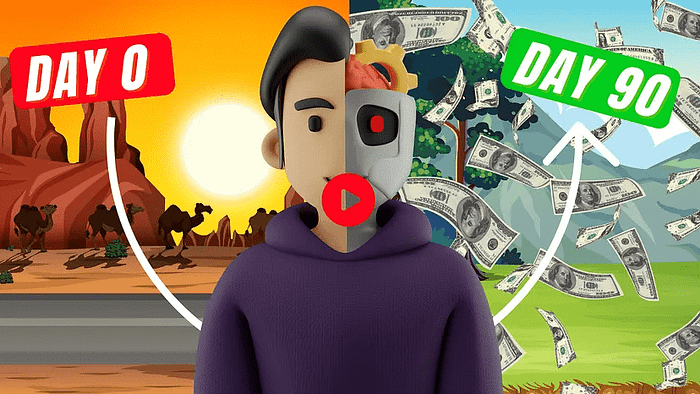Starting a YouTube Channel can be an exciting and rewarding venture, but it requires careful planning and execution to achieve success.
In this comprehensive guide, we will walk you through the 10 essential steps to launch a thriving YouTube Channel, helping you navigate the challenges and maximize your chances of building a strong presence on the platform.
Whether you’re a beginner or have some experience with video creation, these steps will provide you with a solid foundation to create engaging content, grow your audience, and potentially monetize your channel.
So, let’s dive in and explore the key elements that will set your YouTube Channel up for long-term success.
We strongly recommend that you check out our guide on how to take advantage of AI in today’s passive income economy.
Table of Contents
Step 1: Define Your Niche and Target Audience
The first crucial step in launching a successful YouTube Channel is to identify your niche and target audience.
This will help you create content that resonates with your viewers and establishes you as an authority in your chosen field.
Consider your passions, expertise, and the unique value you can offer to your audience.
Research your competition and identify gaps in the market that you can fill with your content.
Once you have a clear understanding of your niche, define your target audience by considering factors such as age, gender, interests, and pain points.
This information will guide your content creation process and help you tailor your message to your ideal viewers.
Remember, a well-defined niche and target audience will make it easier to create consistent, high-quality content that attracts and retains subscribers to your YouTube Channel.
Step 2: Develop a Content Strategy
With your niche and target audience in mind, it’s time to develop a comprehensive content strategy for your YouTube Channel.
This involves brainstorming video ideas, creating a content calendar, and establishing a consistent posting schedule.
Start by generating a list of potential video topics that align with your niche and provide value to your target audience.
Consider a mix of informational, educational, and entertaining content to keep your viewers engaged.
Once you have a list of ideas, organize them into a content calendar that outlines the topics, filming dates, and publishing schedule for your YouTube Channel.
Consistency is key when it comes to building a loyal audience, so aim to post new videos on a regular basis, whether it’s weekly, bi-weekly, or monthly.
Step 3: Invest in Quality Equipment
To create professional-looking videos for your YouTube Channel, it’s essential to invest in quality equipment.
While you don’t need to break the bank on top-of-the-line gear, having reliable tools will enhance the overall production value of your content.
Start with a decent camera that captures high-definition video, such as a DSLR, mirrorless camera, or even a high-end smartphone.
Invest in a good microphone to ensure clear audio quality, as poor sound can quickly turn viewers away from your YouTube Channel.
Consider purchasing a tripod or stabilizer to keep your shots steady and professional-looking.
As your YouTube Channel grows, you can gradually upgrade your equipment to further improve the quality of your videos.
Step 4: Create Engaging and Informative Content
Now that you have your niche, target audience, content strategy, and equipment in place, it’s time to start creating engaging and informative content for your YouTube Channel.
Focus on providing value to your viewers in every video, whether it’s through educational tutorials, entertaining vlogs, or thought-provoking discussions.
Plan your videos by creating outlines or scripts to ensure a logical flow and maintain focus on the key points you want to convey.
When filming, pay attention to lighting, composition, and background to create visually appealing shots.
During the editing process, aim to keep your videos concise and engaging by cutting out unnecessary footage and adding appropriate transitions and graphics.
Remember, the goal is to create content that keeps viewers coming back to your YouTube Channel for more.
Step 5: Optimize Your Videos for SEO
To increase the visibility of your YouTube Channel and attract organic traffic, it’s crucial to optimize your videos for search engine optimization (SEO).
This involves incorporating relevant keywords in your video titles, descriptions, and tags to help YouTube understand the content of your videos and rank them accordingly.
Conduct keyword research to identify the terms and phrases your target audience is searching for and integrate them naturally into your video metadata.
Create compelling titles that accurately reflect the content of your videos and entice viewers to click.
Write detailed descriptions that provide an overview of your video and include relevant links, such as to your website or social media profiles.
Use appropriate tags to help YouTube categorize your videos and suggest them to viewers interested in similar content.
By optimizing your videos for SEO, you increase the chances of your YouTube Channel being discovered by your target audience.
Step 6: Design Eye-Catching Thumbnails
Thumbnails are the first impression potential viewers have of your videos, and they play a significant role in whether someone clicks on your content or scrolls past it.
To create eye-catching thumbnails that entice viewers to watch your videos, use high-quality images that accurately represent the content of your video.
Incorporate text overlays that highlight the main topic or benefit of watching your video, using a clear and readable font.
Use contrasting colors and bold designs to make your thumbnails stand out in the sea of other YouTube Channel content.
Consistency is key when it comes to thumbnails, so develop a recognizable style that aligns with your brand and makes your videos easily identifiable.
Step 7: Engage with Your Audience
Building a strong community around your YouTube Channel is essential for long-term success, and engaging with your audience is a crucial part of that process.
Encourage viewers to leave comments on your videos by asking questions, starting discussions, and responding to their feedback.
Take the time to read and reply to comments, fostering a sense of connection and showing your audience that you value their input.
Consider creating a dedicated space for your community, such as a Discord server or Facebook group, where your viewers can interact with each other and with you beyond the YouTube Channel platform.
Regularly solicit feedback from your audience on the types of content they’d like to see, and use that information to guide your future video creation.
By actively engaging with your audience, you create a loyal community that will support your YouTube Channel’s growth and success.
Step 8: Collaborate with Other Creators
Collaborating with other creators in your niche is a powerful way to expand your reach and attract new viewers to your YouTube Channel.
Identify potential collaborators who share a similar target audience and whose content aligns with your brand values.
Reach out to them with a well-crafted proposal, highlighting the benefits of collaborating and outlining your ideas for a joint video project.
When collaborating, ensure that the content provides value to both your and your collaborator’s audiences and that it fits seamlessly into your respective YouTube Channel’s content strategies.
Promote the collaborative video on both channels and encourage viewers to check out your collaborator’s content, helping to cross-pollinate your audiences.
Step 9: Promote Your Videos on Social Media
To drive traffic to your YouTube Channel and increase your video views, it’s essential to promote your content on social media platforms.
Share your videos on Facebook, Twitter, Instagram, and other relevant platforms, along with engaging captions and hashtags to attract attention.
Create short, compelling teasers or snippets of your videos to share on social media, enticing viewers to click through to your YouTube Channel to watch the full content.
Engage with your social media followers by responding to comments, answering questions, and encouraging them to share your videos with their own networks.
Consider running social media ads to target potential viewers who may be interested in your content but haven’t yet discovered your YouTube Channel.
Step 10: Analyze and Adapt
Finally, to ensure the long-term success of your YouTube Channel, it’s crucial to continually analyze your performance and adapt your strategy accordingly.
Use YouTube Analytics to track key metrics such as views, watch time, audience retention, and demographic information.
Identify which videos are performing well and try to understand why they resonate with your audience.
Look for patterns in your top-performing content and use that information to guide your future video creation and optimize your YouTube Channel’s overall strategy.
Regularly review and update your content calendar based on your analytics insights and audience feedback, ensuring that you’re consistently delivering the types of videos your viewers want to see.
By continuously analyzing and adapting your approach, you can fine-tune your YouTube Channel for optimal growth and success.
Conclusion
Launching a thriving YouTube Channel requires dedication, planning, and a willingness to adapt and grow.
By following these 10 essential steps, you’ll be well on your way to creating a successful platform that engages and grows your audience.
Remember to stay true to your niche, provide value to your viewers, and foster a strong community around your content.
With persistence and a commitment to quality, your YouTube Channel can become a powerful tool for sharing your message, building your brand, and achieving your goals.
So, start putting these steps into action and watch your YouTube Channel flourish.
FAQ
How do I start a YouTube channel?
To start a YouTube Channel, follow these steps:
- Sign in to YouTube using your Google account or create a new account if you don’t have one.
- Click on your profile icon in the top right corner and select “Create a Channel.”
- Choose whether to create a personal channel or a channel using a custom name.
- Customize your channel by adding a profile picture, channel art, and a description.
- Start creating and uploading content that aligns with your niche and target audience.
How do I get my YouTube channel?
To get your YouTube Channel, you need to:
- Sign in to YouTube using your Google account.
- Click on your profile icon in the top right corner.
- Select “Your Channel” from the drop-down menu.
- If you haven’t created a channel yet, you’ll be prompted to create one by following the steps mentioned in the previous answer.
How do I start a YouTube channel and get paid?
To start a YouTube Channel and get paid, follow these steps:
- Create your YouTube Channel by following the steps mentioned in the first answer.
- Produce high-quality, engaging content that attracts viewers and encourages them to subscribe to your channel.
- Grow your subscriber base and viewership by promoting your videos on social media and collaborating with other creators.
- Enable monetization on your channel by joining the YouTube Partner Program once you meet the eligibility requirements (1,000 subscribers and 4,000 hours of watch time in the past 12 months).
- Choose the monetization options that best suit your content, such as ads, sponsorships, or merchandise.
- Continue creating valuable content and engaging with your audience to increase your revenue potential.
How much does it pay to have a YouTube channel?
The amount you can earn from a YouTube Channel varies greatly depending on factors such as:
- The number of views your videos receive
- The niche you’re in and the advertiser demand for that niche
- The engagement rate of your videos (likes, comments, shares)
- The type of ads displayed on your videos
- The geographic location of your viewers
On average, YouTube pays between $0.01 and $0.03 per ad view, which equates to about $3 to $5 per 1,000 video views.
However, top YouTube creators can earn significantly more through various monetization strategies, such as sponsorships, merchandise sales, and crowdfunding.
The key to maximizing your earnings on YouTube is to create high-quality, engaging content that resonates with your target audience and to continually grow your subscriber base and viewership.

We strongly recommend that you check out our guide on how to take advantage of AI in today’s passive income economy.




